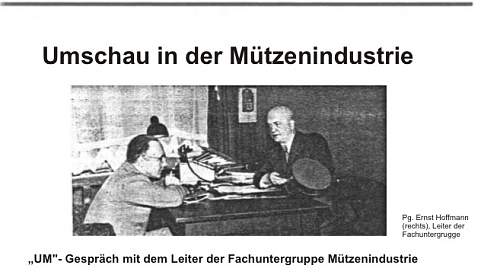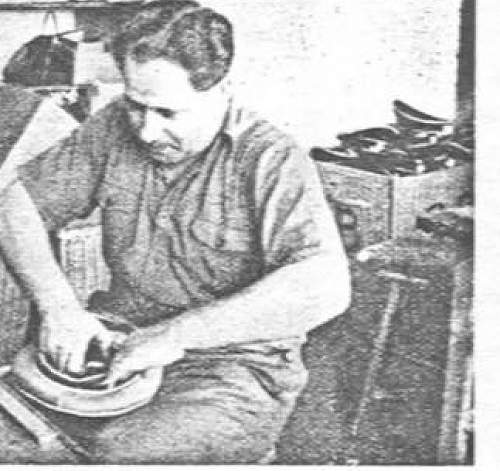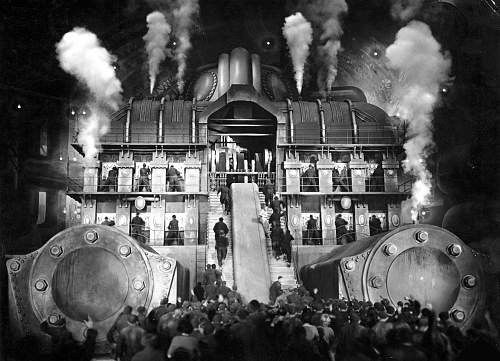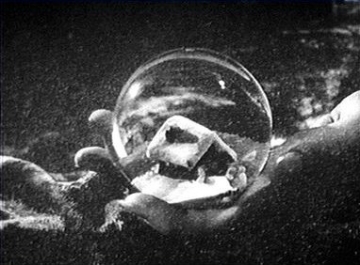-
03-28-2011, 10:30 AM
#451
 Re: Muetzenfabrik
Re: Muetzenfabrik

by
Friedrich-Berthold

The Nazis were obsessed with the effects of public relations, advertising, and propaganda and mass persuasion originating in Britain and the US. These phenomena had overwhelmed Germany in 1914-1918 and became a feature of national socialism in ways that are intriguing. These two books speak to this. One is a year book on German advertising, which is heavily influenced by US and British practice, and the other is a secret PhD dissertation of a propaganda ministry figure on the evolution of political posters from commercial art, and especially their role in the first world war.
Attachment 190099Attachment 190100Attachment 190101Attachment 190102
Here is an article from UM that describes a display at an exhibition that highlights the skills employed in that of the German hat industry and comments on the reactions from foreigners.
"When foreigners approach the booth and I heard said the German cap is superior to foreign, that's a fairly objective opinion"
I find myself wondering if this is a type of propaganda demonstrating the superior production quality of German industry or just a bit of pride in what may have been a trade show similar to what is common today.
Perhaps an amalgam of both.

CMH
-
03-28-2011 10:30 AM
# ADS
Circuit advertisement

-
03-28-2011, 07:20 PM
#452
 Re: Muetzenfabrik
Re: Muetzenfabrik
That article from UM is of general interest for its focus on the matter of exports. Allow me to provide a translation for the non-German speakers:
"Among the industrial fair stands on the Berlin exhibition "Deutschland" (cf. report on pg. 178!), the production display of the Association of the German Cap Industry signifies the new Germany with particular vividness, for on the cap booth there are many caps for the wearers of German uniforms, caps that are a symbol of our time. But, as far as the exhibition is concerned, this industrial fair is purely and exclusively about the performance that is demonstrated by top achievements and which gives vivid proof of high-grade German quality products. How else could it be that, in addition to caps for Germans, there are also caps for a Turkish stationmaster, for the Dutch Colonial Army, helmets of the Swiss National Railways and the Romanian Border Guard, caps of Turkish and Venezuelan Generals as well as infantry and artillery? It is through this that the superior performance of the specialized German industry is most clearly proven; for if performance were not the decisive factor, the difficult export relations could not be maintained. Unfortunately, the uniform has not yet become generally prevalent as an export product and therefore it is doubly significant that the cap industry in its field does not only care about the civilian cap, but about the uniform cap as well. May this very active joint promotion contribute to a good success and further motivation based on the German cap industry's enthusiasm for exports! It is the first cap promotion of this kind and one which without any doubt should also have a favorable effect on the domestic trade.
An intense enhancement of performance - by specialized skills to an improvement of quality - that was the urgent demand that the Head of the Professional Sub Group "Cap Industry" used to preface the Special Cap Issue of "UM" (15 July 1936). The strengthening of the community spirit necessary for this is proven in an excellent way by the reviewed fair promotion and it can also be described as a bugle call of the cap industry that has "fallen in at attention" in order to prove the demanded skills.
If foreigners approach the booth, saying - as we have heard ourselves - that the German cap is superior to the foreign one it is certainly a rather objective judgment.
Out of the Professional Group "Clothing Industry", only the Cap Industry (of course including civilian caps etc.) had participated in the "Deutschland" exhibition. Perhaps their initiative will provide an inspiration for exemplary joint promotion on other occasions beyond their immediate field."
-
03-28-2011, 07:42 PM
#453
 Re: Muetzenfabrik
Re: Muetzenfabrik
Thanks for this very kind and comprehensive intervention. The other piece, of course, was that German economic policy as regards trade of the era was to swap goods outside the pound and dollar import/export regimes. Exports within the goals of autarky formed a central element of regime policy and plainly also a leading feature of the accomplishments of the German uniform trade in an earlier era. There is endless reference in many articles to pre war export successes. UM was not propaganda really in the sense I indicated it above. It was a trade periodical within the goals of the regime, to be sure, but it did not have mass persuasion to a political ideology as its first goal. The organizations that formed the cosmos of the uniform trade in state, economy and society, though, were recipient of propaganda in various forms. The UM is as much a professional advocacy periodical for a specific branch of the economy, whose goal it was, among others, to underscore the virtues of industrial and trade associations within the political economy of Germany of the time. Such has existed prior to 1933 and such exist even today, but, of course, their political agenda prior to 1933 was not Nazi, and surely not so in the years since 1949. Hoffman apparently was a moving force in this cap exhibit at this all Germany exhibition which was trade fair and political propaganda for the regime, as well as similar events at the Leipziger Messe (the trade fair of all world trade fairs in the day) or at a textile industry and trade show held in Berlin in the years 1936, 1937 or 1938. There is mention of the latter in the Vierjahresplan journal I have added elsewhere. I think I have material from this exhibition elsewhere. Economic success under national socialism was vital to the legitimacy of the regime among the German people and also as part of the Nazi effort to make its place in Europe not only by force of arms, but by dint of ideological example, especially in an anti communist and anti liberal capitalist system.
Warm thanks to my German colleague for his fine translation done the old fashion way with grey matter. Vielen Dank! Gruess nach Deutschland!


Last edited by Friedrich-Berthold; 03-28-2011 at 08:23 PM.
-
03-28-2011, 08:37 PM
#454
 Re: Muetzenfabrik
Re: Muetzenfabrik
Thank you for the translation and kindness, as always, HPL2008. My German is still quite far from fluent. Thank you F-B for putting the article into perspective.
Regards,
CMH
-
03-28-2011, 08:42 PM
#455
 Re: Muetzenfabrik
Re: Muetzenfabrik
-
03-30-2011, 04:51 PM
#456
 Re: Muetzenfabrik
Re: Muetzenfabrik
One again, thank-you for your translation, HPL. Although propaganda, there is a kernal of truth to the note about the foreigner's impression of german headwear. At that time, there simply was no other piece of cloth headgear that approached the German Schirmmuetze both in terms of aesthetics and quality. My (obviously biased) opinion is that it still holds true today.
In fact, I will go one step further and be so bold to state that the Sattelform visor was the most aesthetically pleasing piece of headgear of any country, any era.
“Show me the regulation, and I’ll show you the exception.”
-
03-30-2011, 08:04 PM
#457
 Re: Muetzenfabrik
Re: Muetzenfabrik
Yes indeed, many thanks for the translation! I envy those who can effortlessly read the UM, hopefully one day I'll be able to join the ranks too.
A lot of what I've translated so far for myself does smack of propaganda but it's being read out of context in a different era. German industry in the 1930's, especially the hat industry (which nearly disappeared completely) was feeling buoyant after a long period of decline but there's also the sense that they were still unsure of themselves in regards to trade and export. With the USA and UK dominating the industrial production and export of goods, no wonder Germany industrialists were fascinated with the success of these countries. They didn't want to be like the vulgar Americans and Brits but I'm sure they really wanted a big slice of the market.
If I had one question to ask these mutzenmachers in the 30's, it would be whether they think a war would be good for long term business or not! 
-
03-30-2011, 08:44 PM
#458
 Re: Muetzenfabrik
Re: Muetzenfabrik

by
BenVK

Yes indeed, many thanks for the translation! I envy those who can effortlessly read the UM, hopefully one day I'll be able to join the ranks too.
A lot of what I've translated so far for myself does smack of propaganda but it's being read out of context in a different era. German industry in the 1930's, especially the hat industry (which nearly disappeared completely) was feeling buoyant after a long period of decline but there's also the sense that they were still unsure of themselves in regards to trade and export. With the USA and UK dominating the industrial production and export of goods, no wonder Germany industrialists were fascinated with the success of these countries. They didn't want to be like the vulgar Americans and Brits but I'm sure they really wanted a big slice of the market.
If I had one question to ask these mutzenmachers in the 30's, it would be whether they think a war would be good for long term business or not!

Correct. UM is not propaganda in the narrow sense that its editorial policy was directly controlled by Goebbels. It surely had propaganda heavy elements in it, like the article on Assmann on the early years of Nazi retailing in red Berlin and the like. But much of it is perfectly normal trade publication as one would find in many places. The Nazi elements come through in it, and since the well read coffee table book turns a totally blind eye to this aspect of the whole, I have pointed it out. But I would not want to over state it, either, other than how the cap maker fit into the Nazi economy and state bears analysis because his or her posture bears essentially no resemblance to the political economy of today.
I also do not think that the Sattelform cap much interested people at the time, other than it was an aspect of military fashion, and, in fact, one which WENT AGAINST THE REGULATIONS. The regulations followed fashion, and especially the breaking of regulation, which is among the most interesting aspects of UM is how it throws open the reality of these things versus some utterly sparse, incomplete and usually totally wrong assumptions as had by certain collectors based on maybe two to five hundred caps they might have seen. Read Plato's Republic on this score, as a matter of fact, as pertains to reality and shadows of reality.
UM did have the role of explaining the political economy of the time, it did have an aggressive racially motivated role of disenfranchising a minority, but these were the overall goals of the regime.
In any case, thanks to those here who have posted more material and translated it. In order to understand the translations, however, without imposing our own rather narrow and artificial agenda on this source, you need to know a lot more about German society, politics and culture in the early 20th century, which comes across very powerfully in this source.
happy hats.
As to the war, some would have welcomed it, and others would have been pretty doubtful of the outcome, as was generally the mood about same in September 1939.
-
03-30-2011, 09:20 PM
#459
 Re: Muetzenfabrik
Re: Muetzenfabrik

by
Friedrich-Berthold

The regulations followed fashion, and especially the breaking of regulation, which is among the most interesting aspects of UM is how it throws open the reality of these things versus some utterly sparse, incomplete and usually totally wrong assumptions as had by certain collectors based on maybe two to five hundred caps they might have seen.
A very interesting point and prehaps we can explore it further?
The term "extramutze" to me at least usualy means a privately purchased cap outside and therefore not controlled by the Wehrmacht or SS uniform regulations yet many UM articules specifically discuss the extramutze. I've not had the time to translate them yet so cannot determine the nature of the discussions and prehaps I've totaly missunderstood the term so it would be interesting to hear thoughts of others regarding the subject.
-
03-30-2011, 09:54 PM
#460
 Re: Muetzenfabrik
Re: Muetzenfabrik

by
BenVK

A very interesting point and prehaps we can explore it further?
The term "extramutze" to me at least usualy means a privately purchased cap outside and therefore not controlled by the Wehrmacht or SS uniform regulations yet many UM articules specifically discuss the extramutze. I've not had the time to translate them yet so cannot determine the nature of the discussions and prehaps I've totaly missunderstood the term so it would be interesting to hear thoughts of others regarding the subject.
The Extramuetze was bought by the soldier for walking out, or whatever fancier orders of dress for a smart appearance to impress one's darling or parents or to pose in the portrait studio, when the issued cap had a stain on it, had been sweated up by someone or simply did not not look elegant. It did have follow regulation, de jure, but, de facto, it often did not. Wilkins tries to discuss this fact in his book, but does a lousy job of it. The UM speaks at length about non observance of regulations, military fashion and how soldiers embraced their own styles, habits, and breaking of the rules. Often these violations of regulations were later incorporated into regulations just the same--an insight altogether lacking on the maroon lunatic site.
The high crown was originally against the regulation, and it rose in height not as a leading indicator, but as a following indicator of how people wanted their caps to be. The UM authors mention this fact, and there were scholarly circles to analyze all the ways that military fashion had departed from the regulations in the past. Look under "Uniformkunde" as in the society for the study of uniforms, which still exists, actually. Extramuetze is counterpoised to a contract cap, or one (Kammerexemplar) issued from the Kleiderkammer within the quarter master or supply system of the armed forces or whatever agency of party and state. The Extramuetze was a highly profitable item for the readers of UM, granted the re institution of conscription and huge increase in the size of the Wehrmacht as well as other uniformed organizations. But Extramuetze refers mostly to the military. It must have also existed in earlier epochs that is, the old armies.
Last edited by Friedrich-Berthold; 03-31-2011 at 12:44 AM.






 .
.













Bookmarks